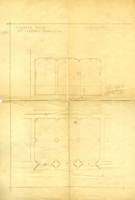Monastery of Santa María de Ovila
Byne, as negotiator for Hearst, purchased yet another monastery in 1931 for $85,000 and arranged for direct shipping to San Francisco. The Cistercian monastery of Santa María de Ovila was originally located in the province of Guadalajara in Spain. Hearst intended for parts of the structure to be incorporated into his new Wyntoon Castle in northern California, after the original family summer residence was destroyed by fire in 1930.
Hearst was particularly interested in using the refectory as a library or armory and the chapter house as part of the indoor swimming pool area. Plans for Wyntoon were abandoned when Hearst's finances declined in the mid-1930s and like Sacramenia, Hearst's extravagant plan for Santa María de Ovila never came to fruition.
Santa María de Ovila was sold to the city of San Francisco in 1941 as part of a plan for a Museum of Medieval Art, a project to be directed by architect Julia Morgan. The necessary money was never raised and the stones of the structure rested behind the De Young Museum in San Francisco until finally in 1994 its architectural elements became the focus of a building campaign at the Abbey of New Clairvaux in Vina, California.
Images from the Archive Three architectural plans of the Monastery were recently discovered among miscellaneous materials in the archive. Details of the 15th Century Gothic church, the 13th century transitional chapter house and the 13th century transitional refectory along with Hearst's original sales record are shown here. Additional architectural drawings of the structure are in the Archivo Merino se Cíceres, Spain.



